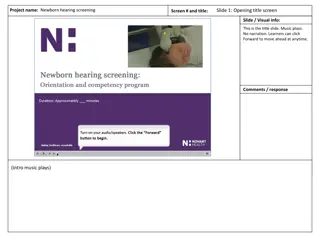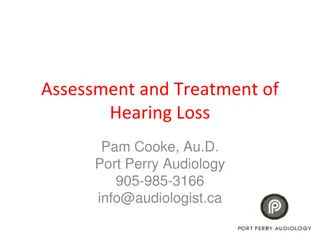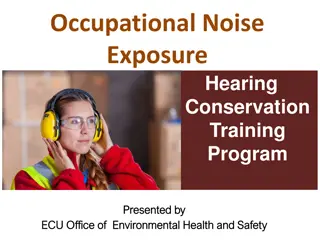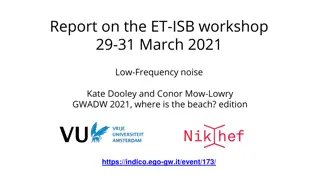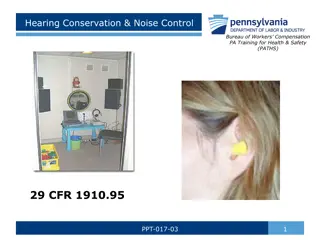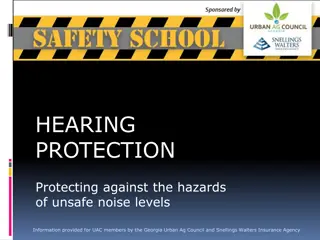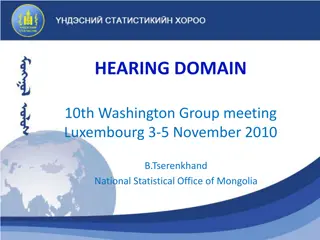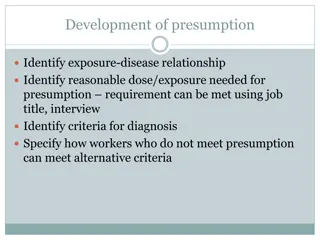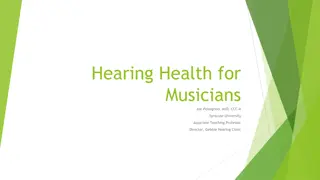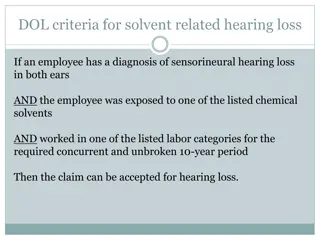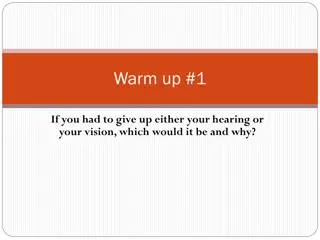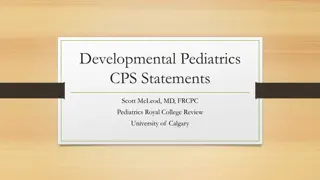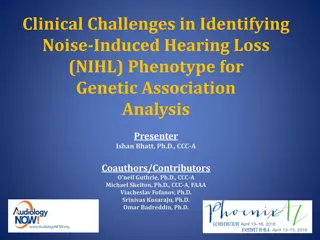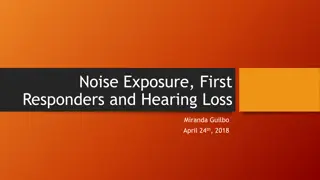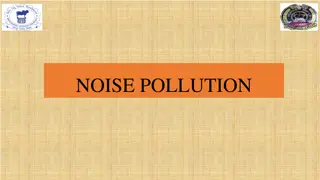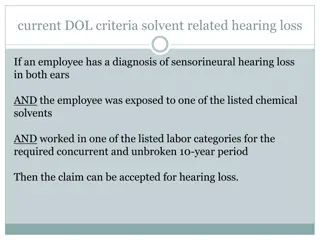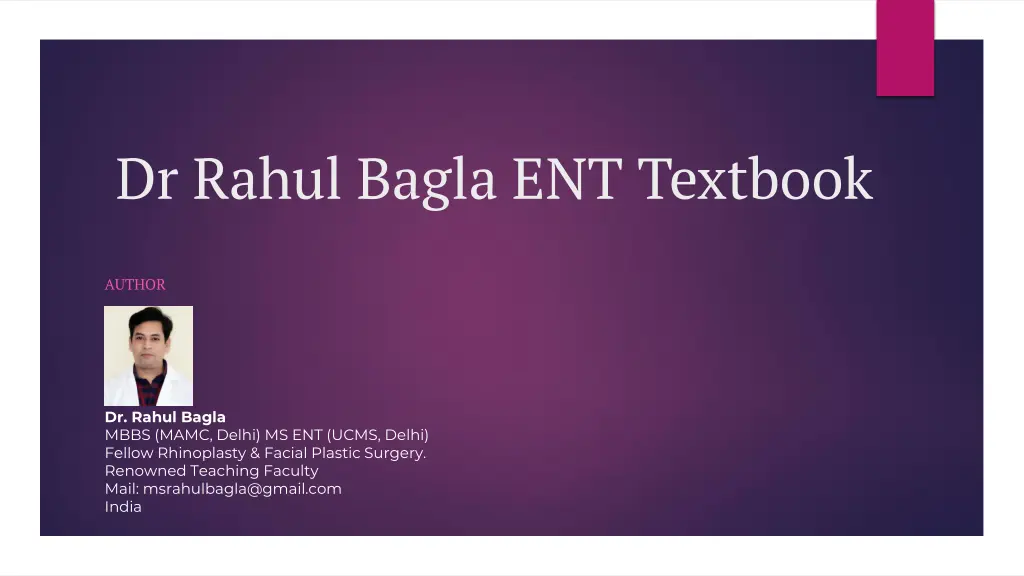
Understanding Noise-Induced Hearing Loss and Prevention
Explore the causes, impacts, and prevention of noise-induced hearing loss (NIHL), a serious issue resulting from chronic exposure to loud noise in workplaces. Learn about Temporary Threshold Shift (TTS) and Permanent Threshold Shift (PTS), the pathophysiology of NIHL, and factors contributing to hearing damage. Take steps to protect your ears from this silent threat.
Download Presentation

Please find below an Image/Link to download the presentation.
The content on the website is provided AS IS for your information and personal use only. It may not be sold, licensed, or shared on other websites without obtaining consent from the author. If you encounter any issues during the download, it is possible that the publisher has removed the file from their server.
You are allowed to download the files provided on this website for personal or commercial use, subject to the condition that they are used lawfully. All files are the property of their respective owners.
The content on the website is provided AS IS for your information and personal use only. It may not be sold, licensed, or shared on other websites without obtaining consent from the author.
E N D
Presentation Transcript
Dr Rahul Bagla ENT Textbook AUTHOR Dr. Rahul Bagla MBBS (MAMC, Delhi) MS ENT (UCMS, Delhi) Fellow Rhinoplasty & Facial Plastic Surgery. Renowned Teaching Faculty Mail: msrahulbagla@gmail.com India
Noise-Induced Hearing Loss AUTHOR DR RAHUL BAGLA
Noise-Induced Hearing Loss: A Silent Threat Subtitle: Understanding Causes, Impacts, and Prevention Noise is unwanted or harmful sound that disrupts comfort and harms health. Noise-induced hearing loss (NIHL) and acoustic trauma are preventable but serious issues. Key focus: How noise affects hearing, who s at risk, and how to protect ears. Visuals: Image of a person covering ears in a noisy environment.
Defining NIHL NIHL results from chronic exposure to loud noise, often in workplaces like factories or construction sites. It s a major occupational hazard, leading to compensation claims for workers. Two types: Temporary Threshold Shift (TTS) and Permanent Threshold Shift (PTS). TTS causes short-term hearing loss that recovers; PTS is permanent due to structural damage. Visuals: Diagram of ear anatomy highlighting cochlea.
TTS vs. PTS Temporary Threshold Shift (TTS): Brief hearing loss from noise exposure, recovering in days. Caused by metabolic changes like reduced blood flow or hair cell stress. Permanent Threshold Shift (PTS): Irreversible loss from repeated noise. Damages actin filaments, hair cells, and inner ear structures. Both affect workers in loud environments and music lovers using high-volume devices. Visuals: Before/after images of healthy vs. damaged hair cells.
Sudden Noise Damage Acoustic trauma occurs from a single, intense sound (140 170 dB), like explosions or gunfire. Causes immediate hearing loss without prior TTS, damaging the tympanic membrane, ossicles, and hair cells. Common in military settings, concerts, or near firecrackers. Results in permanent hearing impairment, often with pain or dizziness. Visuals: Image of a soldier near an explosion.
Factors Causing Hearing Damage Frequency: Sounds at 2 3 kHz are most harmful to ears. Intensity & Duration: Noises over 80 dB are risky; above 130 dB cause instant harm. Continuous Noise: Steady noise is worse than intermittent sounds. Individual Risks: Genetics, smoking, diabetes, or ototoxic drugs increase damage. Visuals: Graph showing safe vs. harmful noise levels.
Why 4 kHz? NIHL often shows a notch at 4 6 kHz in hearing tests. The basal turn of the cochlea, sensitive to 4 kHz, is rigid and prone to damage. Ear canal resonance and muscle reflexes amplify this frequency s impact. This notch helps doctors diagnose NIHL but isn t always present. Visuals: Audiogram with 4 kHz notch highlighted.
Spotting Hearing Loss History: Patients report gradual hearing loss, tinnitus, or sensitivity to sounds. Exams: Ear checks may look normal or show trauma in sudden cases. Tests: Pure-Tone Audiometry (PTA): Detects 4 6 kHz notch. Tympanometry: Checks middle ear function. Otoacoustic Emissions (OAE): Tests hair cell health. Visuals: Image of an audiometry test setup.
Beyond Basic Tests Speech Audiometry: Measures how well patients understand speech. Auditory Brainstem Response (ABR): Checks for nerve issues, like acoustic neuroma. SISI Test: Confirms cochlear damage and spots fake hearing loss. Tone Decay Test: Detects neural issues in hearing pathways. These tools help doctors pinpoint the cause and severity of hearing loss. Visuals: Diagram of ABR testing equipment.
Differential Diagnosis Presbycusis: Age-related hearing loss, gradual like NIHL. Ototoxic Drugs: Medications that harm hearing, mimicking NIHL. Meniere s Disease: Causes hearing loss with vertigo, unlike NIHL. Acoustic Neuroma: Tumor affecting hearing, detectable by ABR. Malingering: Exaggerated symptoms for gain, caught by SISI. Visuals: Table comparing NIHL vs. other conditions.
Workplace Protections Audiograms: Test hearing before and during employment. Noise Limits: Keep noise below 115 dB; avoid impulses over 140 dB. Training: Teach workers about NIHL risks and safety. Ear Protection: Use earplugs (15 30 dB reduction) or earmuffs (30 40 dB). Job Rotation: Move workers away from noisy areas. Visuals: Worker wearing earmuffs in a factory.
Ministry of Labour, Govt. of India, Model Rules under Factories Act:
Protecting Ears at Home Volume Control: Keep music at 60% volume, under 60 dB, for less than 60 minutes. Headphones: Choose noise-cancelling headphones over earbuds. Breaks: Rest ears after loud activities to recover. Seek Help: Visit an ENT if tinnitus or hearing issues appear. These steps prevent damage from concerts or personal devices. Visuals: Image of headphones with volume control icon.
Legal Noise Limits Factories Act: Limits workplace noise to 90 dB for 8 hours. Noise Pollution Rules 2000: Sets quiet zones near hospitals and schools. Environment Protection Rules 2006: Bans firecrackers over 125 dB. Area Limits: Industrial: 75 dB (day), 70 dB (night). Residential: 55 dB (day), 45 dB (night). Visuals: Chart of permissible noise levels by area.
Managing Hearing Loss Hearing Protection: Use earplugs or earmuffs to prevent further damage. Hearing Aids: Help with severe, permanent loss; cochlear implants for profound cases. Medications: Prednisolone and piracetam may aid sudden loss recovery. Tinnitus Therapy: Tinnitus Retraining Therapy (TRT) improves 60-70% of cases. Hyperacusis: Managed with sound therapy and counseling. Visuals: Image of a hearing aid.
Non-Auditory Impacts Noise causes sleep problems, leading to fatigue and stress. It raises blood pressure and heart rate, risking heart issues. Loud sounds spark annoyance, irritability, and mood changes. Work performance drops, and memory weakens. These effects show noise harms more than just ears. Visuals: Image of a stressed person in a noisy environment.
Act Now to Protect Hearing Noise-induced hearing loss is preventable with ear protection and awareness. Workers, music lovers, and motorbike riders face high risks. Use earplugs, limit volume, and follow noise laws to stay safe. Early testing and treatment can reduce damage and improve life. Clean, quiet environments are a right for all! Visuals: Call-to-action graphic with ear protection symbols.

